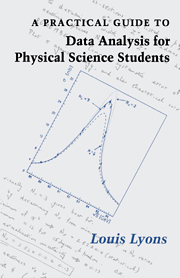Book contents
- Frontmatter
- Contents
- Preface
- Glossary and Conventions
- 1 Experimental errors
- 2 Least squares fitting
- Appendix 1 Useful formulae
- Appendix 2 Partial differentiation
- Appendix 3 The binomial distribution
- Appendix 4 The Poisson distribution
- Appendix 5 Student's t distribution
- Appendix 6 Statistical tables
- Appendix 7 Random numbers
- Index
Appendix 3 - The binomial distribution
Published online by Cambridge University Press: 05 June 2012
- Frontmatter
- Contents
- Preface
- Glossary and Conventions
- 1 Experimental errors
- 2 Least squares fitting
- Appendix 1 Useful formulae
- Appendix 2 Partial differentiation
- Appendix 3 The binomial distribution
- Appendix 4 The Poisson distribution
- Appendix 5 Student's t distribution
- Appendix 6 Statistical tables
- Appendix 7 Random numbers
- Index
Summary
In Section 1.5 we discussed the Gaussian distribution. In this and the next appendix, we describe the binomial and Poisson distributions.
Let us imagine that we throw an unbiassed die 12 times. Since the probability of obtaining a 6 on a single throw is 1/6, we would expect on average to end up with two 6's. However, we would not be surprised if in fact we obtained 6 once or three times (or even not at all, or four times). In general, we could calculate how likely we are to end up with any number of 6's, from none to the very improbable 12.
These possibilities are given by the binomial distribution. It applies to any situation where we have a fixed number N of independent trials, in each of which there are only two possible outcomes, success which occurs with probability p, or failure for which the probability is 1 — p. Thus, in the example of the previous paragraph, the independent trials were the separate throws of the die of which there were N = 12, success consisted of throwing a 6 for which the probability p =1/6, while failure was obtaining any other number with probability 5/6.
The requirement that the trials are independent means that the outcome of any given trial is independent of the outcome of any of the others. This is true for a die because what happens on the next throw is completely unrelated to what came up on any previous one.
- Type
- Chapter
- Information
- Publisher: Cambridge University PressPrint publication year: 1991



